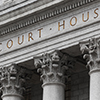Quarterly Journal 46-2
In This Section
The AIPLA Quarterly Journal, a publication of the American Intellectual Property Law Association, is housed at the George Washington University Law School and is edited and managed by an Editorial Board of intellectual property experts and a staff of law students under the direction of the Editor-in-Chief, Professor Joan Schaffner.
The Quarterly Journal is dedicated to presenting materials relating to intellectual property matters and is published four times per year. Editorial Board members (all of whom are lawyers) are selected based upon demonstrated interest and experience, and student staff members are selected from the students of the GWU Law School.
 Do Heightened Quality Incentives Improve the Quality of Patentability Decisions?: An Analysis of Trend Divergences During the Signatory Authority Review Program
Do Heightened Quality Incentives Improve the Quality of Patentability Decisions?: An Analysis of Trend Divergences During the Signatory Authority Review Program
Eric D. Blatt, Lian Huang
Do Heightened Quality Incentives Improve the Quality of Patentability Decisions?: An Analysis of Trend Divergences During the Signatory Authority Review Program
Despite widespread consensus that the quality of patentability determinations must be improved, there has been no agreement as to how this objective should be pursued. A lack of understanding as to the effects of the United States Patent and Trademark Office’s (USPTO) production and quality incentive policies may have presented a barrier to such
 Virtually Equivalent: Applying the Doctrine of Equivalents to Patented Inventions Depicted in Virtual Reality
Virtually Equivalent: Applying the Doctrine of Equivalents to Patented Inventions Depicted in Virtual Reality
Connor J. Hansen
Virtually Equivalent: Applying the Doctrine of Equivalents to Patented Inventions Depicted in Virtual Reality
 Limiting the Expanding Scope of Assignor Estoppel in Federal Courts
Limiting the Expanding Scope of Assignor Estoppel in Federal Courts
Maleena Paal
Limiting the Expanding Scope of Assignor Estoppel in Federal Courts
 The Music Industry’s Discord with the DMCA
The Music Industry’s Discord with the DMCA
Jessica E. Gopiao
The Music Industry’s Discord with the DMCA
Upcoming Events
-
 AIPLA CLE Webinar: Preparing Patent Specifications for AI Inventions - US, Europe and UK and Possible Consequences
AIPLA CLE Webinar: Preparing Patent Specifications for AI Inventions - US, Europe and UK and Possible Consequences
December 2, 2025 12:30 PM to 2:00 PM | Eligible for up to 90 Mins CLE
What does recent case law tell us about subject matter eligibility? What about sufficiency? How open is the USPTO’s more “open door”? At the USPTO, August’s memorandum “Reminders on evaluating subject matter eligibility of claims under 35 U.S.C. 101” was closely followed by Director Squires’ Appeal Review Panel decision (Desjardins) overturning a PTAB §101 rejection and stating that §§102, 103 and 112 are the important criteria for determining AI patentability. Where does this leave us? In Europe and in the US, what does case law tell us about sufficiency and best drafting practice? We will also try and explore possible consequences of these drafting practices on subsequent disputes. -
.png?sfvrsn=9aa26827_1) 2026 AIPLA Virtual Corporate Practice Institute
2026 AIPLA Virtual Corporate Practice Institute
January 13 to 20, 2026 | Up to 360 Minutes of CLE
The Corporate Practice Institute is not a bootcamp. This program provides in-depth insight for in-house corporate counsel and agents to learn about wide ranging legal issues affecting their practice from experienced practitioners. It is designed for experienced in-house attorneys and new in-house attorneys learning to manage new corporate environments and challenges not taught in law schools or private practice. The Institute also helps private practice attorneys, especially associates, prepare for potential in-house career moves. The program also provides valuable networking opportunities to connect with each other and learn from each other's experiences. This online, CLE-program spans two half-days, from Noon – 5:00 pm Eastern and includes 3 one-hour education sessions and a networking session each day. -
.png?sfvrsn=fb5905da_1) 2026 IP Transactions Bootcamp
2026 IP Transactions Bootcamp
February 12, 2026
This in-person-only bootcamp is designed to provide practical insights and strategies for professionals working in intellectual property transactions. The day features a comprehensive agenda including: Panels and CLE Sessions: Learn about Working with Tech Transfer Offices, Strategies for successful collaborations between nonprofits and industry, and Protecting and monetizing an AI asset. Drafting and Negotiating Tips: Get practical advice on drafting and negotiating strategic collaboration and license agreements. Hands-on Workshop: Participate in a Mock licensing negotiation to put your skills to the test. Networking: Conclude the day with a dedicated Networking reception. Registration Coming Soon! -
-(1).png?sfvrsn=7a1054_1) 2026 Trade Secret Summit
2026 Trade Secret Summit
March 26 to 27, 2026
The AIPLA Trade Secret Summit is the leading trade secret conference in the nation, with speakers from across the spectrum of private practitioners, in-house counsel, government, and academia, as well as fantastic networking opportunities. CLE credits will be available. -
2025 Women in IP Global Networking Event
April 16, 2026

